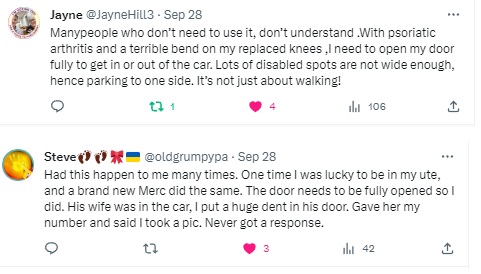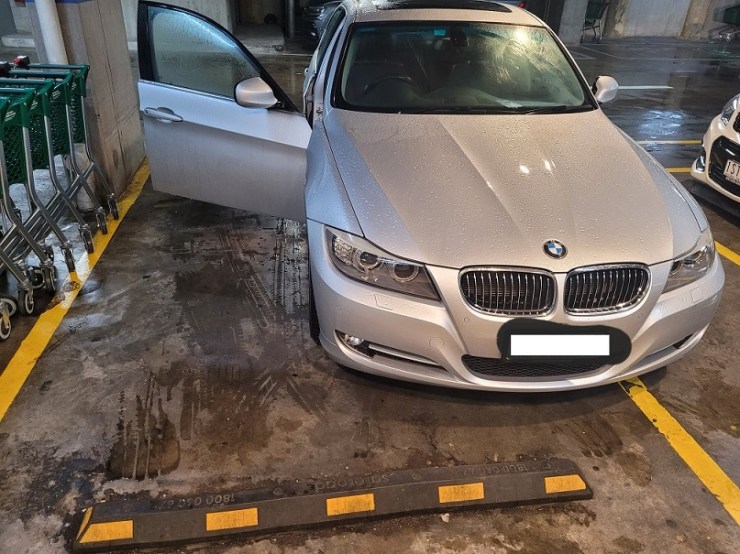Today the final report of the royal commission into violence, abuse, neglect and exploitation of people with disability was released. At the end of this article are links to information about the findings.
By sheer coincidence, on Wednesday this week I had an interesting encounter in a disability car space.
I shared the information on X (previously known as Twitter). Some of the responses blew me (and many other people) away. No wonder the royal commission was needed: just at this simple level of disabled life the responses were incredible. Many were very quick to blame me for the black car’s illegal parking!
Let me set the scene. I’d been for a skin scope late in the afternoon. I drove from there to my local shopping centre to collect a prescription from the pharmacy and grab four items from the supermarket (i.e., not a long visit to the shopping centre). I parked my car in the leftmost disability park beside a pillar – that is no-one would be parking to my left. Looking at the picture, you can see the pillar to my left, creating a gap between my park at the next bank of spaces.

When I came back from my quick errands, I discovered someone had decided to squeeze in beside me. The yellow line demarking my space can be clearly seen under the left side of the black car’s number plate. There was no way known I could get into my car, even if I’d been a perfectly healthy person back in my thirties!
The car was not displaying a disability parking permit. If the driver did have a disability permit, there is no way the car would be parked as it was. The permit in the window of that car is a residency parking permit – it allows street parking where the car owner lives. The purpose of those permits? An example is a friend of mine lives near a public hospital. The residents in surrounding streets all have these permits, otherwise they’d never get a park near their home.
I called the shopping centre management. They suggested I just wait, the driver would probably only be a few minutes. Probably? What if the driver had gone to dinner at a local restaurant? Gone to the gym upstairs? Centre management agreed to send a security guard. I waited. Several other customers stopped to lend me their emotional support, even though they couldn’t do anything. My plan at that point was to ask the security guard if he could get into my car and back it out for me.
Near the end of this adventure, I was turned away from the cars, watching the escalator to see if I could spot the security guard. I turned back to see the boot of the black car open. The driver then tried to sneak into his car unnoticed! I suspect as he returned to his car, he saw my bread and backpack on my hood and realised he’d stuffed up. Yes, it was a he. Not a young one either, I’d hazard a guess my generation, a tad younger than I am. He was hoping to escape unchallenged.
I’ll admit I was not happy and I did swear.
Me: “How the fuck could you do that?”
Him: “Easy!”
Lovely attitude. As he drove away he screamed at me something about photos, but photos was the only word I heard. I assume he didn’t like that I had taken evidentiary photos of him.
The security guard turned up just after the driver had left. We discussed the incident and I provided all necessary information, including the photos. Drove home and made a police report.
That is not the end of the story though. I posted the saga to X.
Well, all hell broke loose! I was told I should park in the middle. Umpteen times. Let me assure you this doesn’t always work. Different disabled people need different space to enter and exit vehicles. They may have any of a walking stick, crutches, a walker, a wheel chair or even a hoist involved. When I park my car, I don’t know what the next vehicle may need or whether they will park to the left, the right, or in the middle of the adjacent park (to my right). It will depend on their needs. By parking to the left as I have, I am allowing maximum flexibility for the next car and given I am next to a pillar, I am not restricting anyone who may park to my left. I also have the room I need. Well, at least I did when I parked my car. Yes, parking in the middle is standard and necessary in narrow, normal car parks. It doesn’t quite work that way in disability parking spaces.
Different parking spots are marked differently. Here are two disability spots at a local park. As you can see, one is delineated, the other not.

Then the issue of MY disability parking permit came up. Shock, horror, it was hidden by my backpack in the photo. Lots of responses telling me I was at fault as my permit wasn’t where it was supposed to be, according to them. I have NO idea how this excuses the illegal parking by the guy in the black car, but here we are.
According to VicRoads, I was fine. I can assure readers it WAS clearly visible on my dashboard, not just where other people thought it should be.

One reply even asked me what I’d do if all the disability spots were taken, as if to imply I really didn’t need one anyway – now what on earth that had to do with the guy illegally parking is beyond me.
Several seemed to think the only “disability” I had was my recent knee surgery, rather than see I had clearly stated PsA. No, I don’t expect people to know what PsA is – we are a mere 1% of the population – but if you don’t know, perhaps ask – do not assume it is “nothing”.
Many people were supportive, here are two examples:

Others shared their own experiences.

However, the number of replies that effectively blamed me, the disabled person, for the OTHER person’s illegal parking was astounding! I had to wonder how many of them have snuck into disability car parks when they shouldn’t. Guilty consciences? There are other considerations too. In my case I needed to be home on time to take medication at a specific time. Another person may have been heading to a medical appointment. Being stuck there for any length of time could be really problematic for some people.
Edit 30/09/2023: After publishing this, I had an another thought. There was a lot of emphasis, in the replies to my original thread, on how I should prevent others doing the same thing. Why? Even one of my own friends said it! How has society got to point I (or anyone) can’t just depend on others to DO THE RIGHT THING? Why should we have to be on the defensive ALL the time, to our own detriment (in this case, less space)? Just do the right thing! It isn’t that hard.
Edit 05/10/2023: On the weekend following the above experience, I happened to be in the same car park and took some photos to demonstrate the practicalities we face. The experience that day just happened to be a good example of how parking in the middle doesn’t always work.

In above photo, I have parked in the first disability spot in this part of the car park. as can be seen, there is a pillar on my right (driver’s) side and a delineated clear space to my left. Quite obviously I am NOT parked in the middle of this space: I think it is obvious that had I parked in the middle I would NOT have been able to open my car door fully due to the shopping carts left in the space in front of the pillar. Also, even to open the door as I have, I am clearly NOT within the delineated space. So I moved to another space. Let’s see how that works in practice.

In this space I have parked in the middle. Again there is a pillar on the driver’s side, so a space between my car park and the next one over. However, see where that car (my driver’s side) is parked? Right on the edge of their space. So, if the pillar was not there, I would not have been able to park in the middle – as can be seen, my open door extends over the edge of my car space and would hit that vehicle. Or I could come back to my car and find that space full of shopping carts, like the previous photo. Again, I’d not be able to fully open my car door, therefore would be unable to get into my car. The car parked on my passenger side is parked in the middle of that space, but is a smaller vehicle, may not need to open the door fully, or there may be pillar space on the passenger side of that vehicle and perhaps it is the passenger, not the drive, that needs the space. Every case is different, which is something people forget!
End of edits
No wonder we needed a royal commission! This was, in comparison to some, a very minor issue. The social attitudes it highlighted were shocking.
New Disability Rights Act needed to end abuse and exploitation, royal commission finds – The Guardian
Australia’s Disability Representative Organisations call for healing – Inclusion Australia




